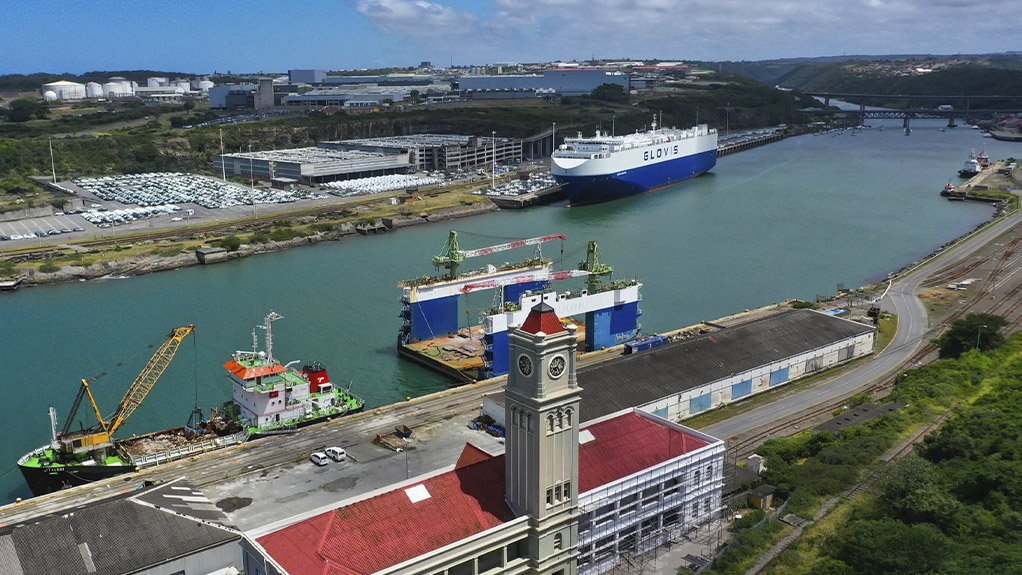Geotech study by SRK for East London port rehabilitation
This article has been supplied.
As part of the proposed rehabilitation of the century-old Quay Wall 3 at the Port of East London, SRK Consulting has completed a geotechnical investigation to assess ground conditions at the site.
Extensive upgrades are planned for the quay and other port infrastructure by Transnet National Ports Authority (TNPA). The Port of East London is South Africa’s only river port, situated at the mouth of the Buffalo River in the Eastern Cape. In addition to being an export hub for the region’s automotive sector, the port also handles key commodities such a dry bulk grains, livestock and processed foods.
Appointed by Geomech Africa (the contractor), SRK prepared the interpretive report on the borehole cores and test pits, according to Brent Cock, principal engineering geologist at SRK Consulting.
“The report was based on marine-based and land-based vertical rotary core drilling – as well as test pits – completed by the contractor,” said Cock. The fieldwork phase of the project involved drilling four marine-based drill holes to a depth ranging from 10 m and 16 m below the river bed, and four land-based drill holes below the quay wall platform – terminating at a depth ranging from 17,5 m to 20 m below the platform surface.
Dynamic Probe Super Heavy (DPSH) tests were also conducted from the river bed level and from below the quay wall platform. Three test pits were hand-excavated to depths of up to a metre deep, below the quay wall concrete platform surface to expose the underlying layer works.
“SRK logged the borehole cores and profiled the test pits, identifying and demarcating representative soil and rock samples for testing,” he explained. “After specifying which tests were to be carried out on the samples including a review of the results, we prepared the geotechnical investigation interpretive report.”
Tests were conducted on the upper and lower horizons of the layerworks, as well as on rockfill and marine sand. Among the variables tested were the particle size distribution, shear strength and compressibility of the soil horizons and compressive strength of the bedrock. The investigation also evaluated the excavation conditions that were likely to be encountered on the site, in terms of the SANS 1200D standard.
The current quay wall consists of a mass concrete gravity structure founded on a mass concrete foundation cast either within marine sand or directly on the underlying bedrock. The proposed new quay wall is planned for construction four metres in front of the existing wall.
“Being a busy port, the work had to be carried out within a live environment with due regard to strict health and safety protocols, taking into account the movement of shipping, all completed by the contractor without incident and to a very high standard,” he said.
Cock highlighted that the information gathered, and recommendations derived from a geotechnical study are important to assist the design engineer in designing a safe and cost effective foundation solution for the structure. The findings of this geotechnical report will inform the final design of East London harbour’s new quay wall, providing vital data to confirm the preliminary design assumptions.
Article Enquiry
Email Article
Save Article
Feedback
To advertise email advertising@creamermedia.co.za or click here
Comments
Press Office
Announcements
What's On
Subscribe to improve your user experience...
Option 1 (equivalent of R125 a month):
Receive a weekly copy of Creamer Media's Engineering News & Mining Weekly magazine
(print copy for those in South Africa and e-magazine for those outside of South Africa)
Receive daily email newsletters
Access to full search results
Access archive of magazine back copies
Access to Projects in Progress
Access to ONE Research Report of your choice in PDF format
Option 2 (equivalent of R375 a month):
All benefits from Option 1
PLUS
Access to Creamer Media's Research Channel Africa for ALL Research Reports, in PDF format, on various industrial and mining sectors
including Electricity; Water; Energy Transition; Hydrogen; Roads, Rail and Ports; Coal; Gold; Platinum; Battery Metals; etc.
Already a subscriber?
Forgotten your password?
Receive weekly copy of Creamer Media's Engineering News & Mining Weekly magazine (print copy for those in South Africa and e-magazine for those outside of South Africa)
➕
Recieve daily email newsletters
➕
Access to full search results
➕
Access archive of magazine back copies
➕
Access to Projects in Progress
➕
Access to ONE Research Report of your choice in PDF format
RESEARCH CHANNEL AFRICA
R4500 (equivalent of R375 a month)
SUBSCRIBEAll benefits from Option 1
➕
Access to Creamer Media's Research Channel Africa for ALL Research Reports on various industrial and mining sectors, in PDF format, including on:
Electricity
➕
Water
➕
Energy Transition
➕
Hydrogen
➕
Roads, Rail and Ports
➕
Coal
➕
Gold
➕
Platinum
➕
Battery Metals
➕
etc.
Receive all benefits from Option 1 or Option 2 delivered to numerous people at your company
➕
Multiple User names and Passwords for simultaneous log-ins
➕
Intranet integration access to all in your organisation





















